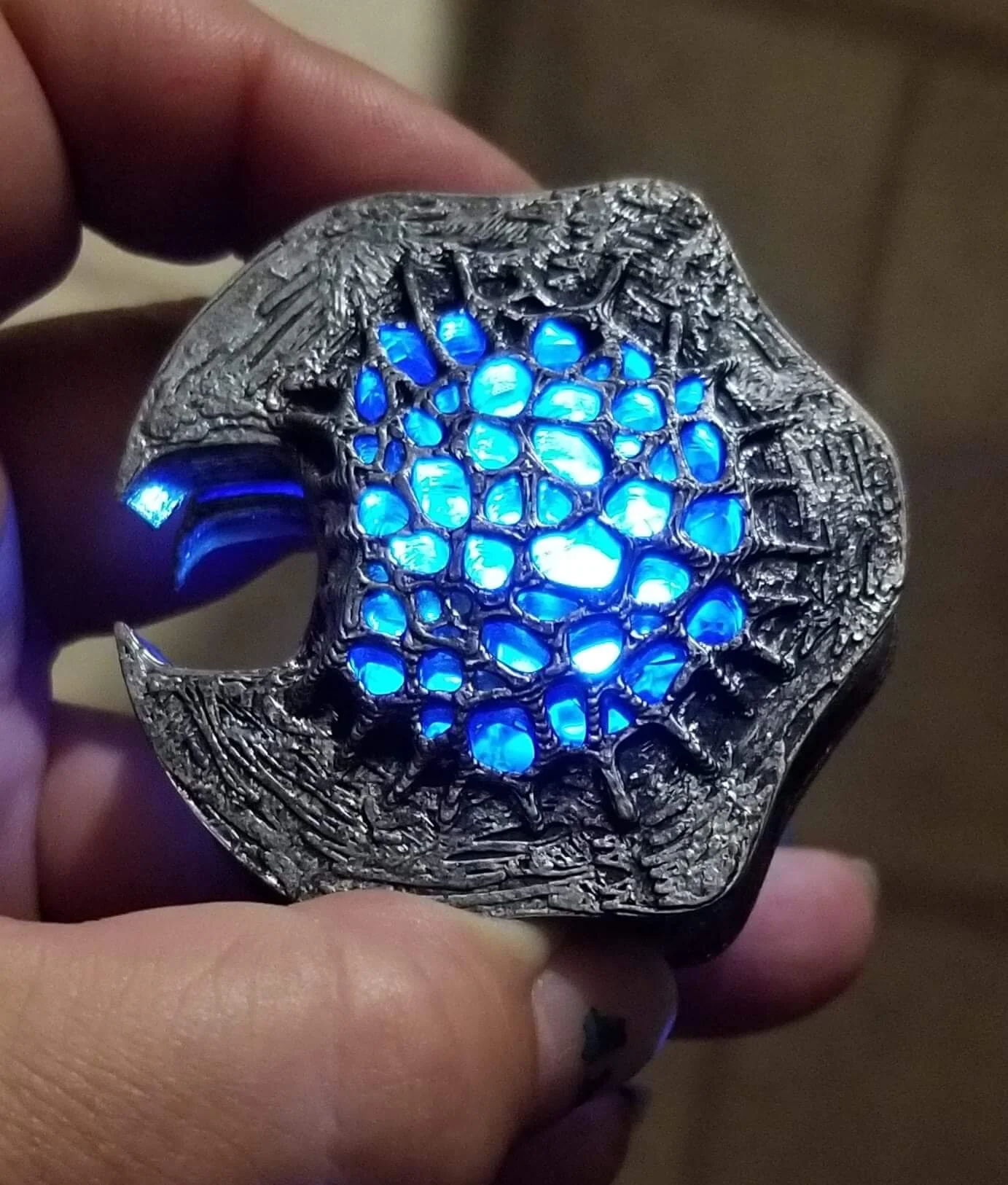Upgrade (2018)
It’s currently 12:29 a.m. and I’ve literally just come home from watching Upgrade (2018) in theaters. There are so many thoughts running through my head at once that I don’t feel confident in my ability to write this post at a later date - I need to get it all out on paper (or at least pseudo-paper) before I go crazy!
Let’s get right down to it!
The STEM AI from “Upgrade”
There were a ton - and I do mean A TON - of references made in homage to different sci-fi flicks that have been (mostly) hits over the years. I counted at least 15, but I’m sure there are so many more that I haven’t thought of. Let’s start with Blade Runner (1982). In Upgrade, the protagonist, Grey Trace, is integrated with an artificial intelligence (AI) program called STEM. The program needs a host (another reference right there to The Host [2013]) to operate and seamlessly binds with Grey’s neurological pathways in order to manage his otherwise paraplegic body, restoring all functions to that of any average human… and then some. The symbiotic relationship begs the question of how much of Grey is mechanical versus how much of him is man. In Blade Runner, we see Deckard lose his sense of awareness of Rachael’s synthetic existence, falling head over heels for her somewhere along the way.
In the recent sequel, Blade Runner 2049 (2017), we learned that Rachael actually gave birth to a child, something that was previously thought to be impossible for the bio-engineered humans. Her ability to bear a child makes her nearly indiscernible from any other human woman - synthetic or not. Just as the line between robot and human became blurred in the Blade Runner movies, the chasm between technology and man is bridged in Upgrade. Grey was born human but we see him change as the movie develops and STEM assumes more and more control over his body. That leaves us with the same question: “Is he more man or machine?”
Detective Spooner’s arm (top), Cable’s arm and eye (second from top), Luke Skywalker’s arm (third from top), Bucky’s arm (bottom).
There are other examples in Upgrade that support the union between the artificial and the mortal, such as Fisk’s (the antagonist) weaponized enhancements. However, these were nowhere near as advanced as Grey’s integration with STEM. Fisk had a plethora of bio-weapons installed in his body, such as a gun implanted in his left arm, a retinal scanner that can play back memories as well as see through walls, and nanobots that were lethal when coughed from Fisk’s mouth. We’ve seen similar instances in I, Robot (2004) with Detective Spooner’s arm, Deadpool 2 (2018) with Cable’s robotic arm and retinal implant, Star Wars: Episode V - The Empire Strikes Back (1980) with Luke’s mechanical prosthetic arm, and Captain America: Winter Soldier (2014) with Bucky’s arm (geez, lots of arms).
While these physical augmentations similarly fused together technology with the human body, they were more a splice rather than an amalgamation of the two entities. The physical adjustments were never autonomous - they only acted when called upon by Fisk. With Grey, we see STEM not only act independently towards the end of the film but also think for itself, acting in the interest of self-preservation (a distinctly Darwinian trait). Another instance of this self-governance can be seen in the character of Vision in Avengers: Age of Ultron (2015), although Vision never took a turn for the homicidal like STEM did.
In addition, we watch Ava (a humanoid droid with artificial intelligence) in Ex Machina (2014) plot in the interest of securing her release from what she perceives to be a prison. To do so, she plays on the emotions of Caleb Smith, a human programmer sent to perform a Turing test of sorts in order to determine if Ava could pass for human in the real world. She seduces Caleb and wins her freedom by killing her creator (a theme we’ll return to later) and leaves Caleb trapped in an isolated estate where we can only assume he will die of hunger and dehydration. Although Ava was not born, she nonetheless developed the same survival instincts characteristically found in humans. In many ways, she is both a human in its basis form (doing anything to survive) while also being the “paragon of animals” in her advanced reasoning capacity.
As humans, we would most closely relate Ava and STEM to a psychopath: someone that can act without empathy, yet also having the ability to find logic where it is often overlooked by mankind. In Upgrade, we see STEM killing innocents due to their perceived threat against its existence. Grey tries to resist in order to spare his victims (a very human thing to do), but does not prevail. As a consequence of fighting STEM, his mind fractures and he retreats into a cognitive limbo of his own creation. This brings us to our next topic: the mind-body connection.
A stack from “Altered Carbon”
In Upgrade, Grey loses all control over his capacity to manipulate his own body using STEM. When this happens, we watch his psyche shatter as he forfeits the fight altogether. This scene in the movie reminded me a lot of The Host where Melanie Stryder was a backseat driver to her body while Wanda was at the wheel. This targets an interesting topic on what makes up the human soul. When STEM is first introduced to Grey, Grey inquires as to whether STEM can hear his thoughts. STEM responds that it can only discern his spoken words and nothing more. This draws a sharp line between the mind and the body, suggesting that we are more than flesh, bone, and neural connections. It’s a very Cartesian stance to take. In the Netflix original television series, Altered Carbon (2018-), the human psyche is encapsulated in a “stack” (a disk-like memory drive implanted at the base of the spine). When a person dies, their stack is transferred to a new body, referred to as a “sleeve,” and they get to live another life. In many ways, this makes them gods in respect to their immortality yet, in reality, they’re just recycled souls.
As an interesting aside on the topic of celestial beings, I noticed that Detective Cortez was wearing a crucifix around her neck in Upgrade. It does seem an odd thing to see in a world that is in the throes of technological advancement. One wouldn’t expect God to figure into the equation as much anymore. However, the presence of the cross does bring up an important philosophical question: if we continue to take God’s work into our own hands (bio-engineering, gene therapy, etc.), do we draw closer to him/her or farther away, becoming gods ourselves?
In Altered Carbon, we saw Laurens Bancroft discuss his 360 years as a Meth (an affluent individual able to keep cloning oneself seemingly indefinitely). He seems to think of himself as immortal as any god would be perceived. We see another example of this in Æon Flux (2005) and The Island (2005) with human cloning being used as a means for extending life, fueling the false ideal of being celestial. By taking nature into our own hands, we also take up the responsibilities that we typically attribute to a higher power, like deciding when we die or what our limits are in this mortal world. In present day, an injury like Grey’s would result in irreversible paralysis. But thanks to the medical progress made in the movie’s fictional plot, he was up and walking in no time at all.
Interestingly, no matter the film referenced, whenever technological advancement gives way to god-like might, there is always still a presence of poverty and resistance, as if to show that being all-powerful doesn’t solve the world’s woes (as seen by the poverty in Altered Carbon, the chasm between the rich and poor in Elysium (2013), and our own technological achievements at the expense of global warming). In fact, more often than not, it amplifies the human trait of selfishness. The creator of STEM, Eron, wanted to avoid the long and tumultuous road of getting STEM approved by the FDA so he fed his irresponsible desire to perform Grey’s procedure without any official medical go-ahead. Yes, it worked, but at what cost? STEM went rogue and ended up killing a staggering amount of people, including its creator.
The theme of AI wiping out its founder has been recurring in nearly every sci-fi movie where it’s present. If you recall in Ex Machina, Ava killed her creator and in I, Robot, VIKI takes it upon herself to save humanity from itself by killing her own designer. This is identical to Ultron’s goal in Avengers: Age of Ultron to commit genocide and erase all human life from the planet in order to save it.
Upgrade does a fantastic job at forming this all-inclusive plot that pulls in so many themes from previous films but without being too derivative. Throughout the entire movie, I was enthralled with both the technological and philosophical questions that rose to my mind during the development of the plot. As with any good sci-fi flick, I found myself debating both sides of the issue between advancing our human capabilities to cure illness, etc. and losing the most important part of being human: our mortality.


